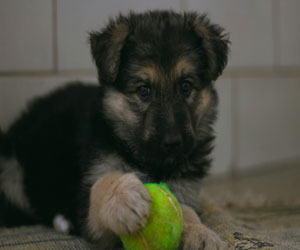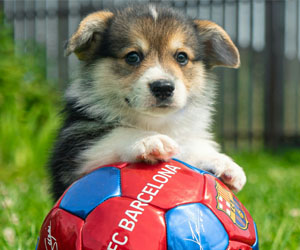



Training your furry friend can be both a rewarding and challenging experience. Whether you have a new puppy or an older dog, effective training techniques are essential to ensure a well-behaved and happy canine companion. In this article, we'll explore some proven techniques for dog training that will help you build a strong bond with your pet and foster positive behaviors.
Positive Reinforcement
Positive reinforcement is a cornerstone of effective dog training. This technique involves rewarding your dog with treats, praise, or affection when they exhibit the desired behavior. By associating good behavior with positive outcomes, your dog is more likely to repeat those actions. Consistency in providing rewards and timely reinforcement is key to success.
Clicker Training
Clicker training is a precise and efficient method that pairs a distinct sound (the click) with a reward. Dogs quickly learn to associate the click with good behavior and become more responsive to training cues. Clicker training allows for clear communication and is especially useful for teaching complex tricks and commands.
Obedience Training
Obedience training is a structured approach to teaching your dog essential commands like sit, stay, and come. This technique establishes a foundation for good behavior and ensures your dog's safety in various situations. It is essential to practice obedience commands regularly to reinforce your dog's understanding.
Consistency
Consistency is a vital element in dog training. Use the same commands and cues consistently, so your dog can easily understand what you expect from them. Everyone in your household should be on the same page regarding training techniques and reinforcement to avoid confusing your dog.
Socialization
Socialization is critical for puppies and older dogs alike. Exposing your dog to different people, animals, and environments helps them develop into well-adjusted pets. Socialization can reduce fear and aggression while improving overall behavior and adaptability.
Exercise And Mental Stimulation
A tired dog is a well-behaved dog. Regular exercise and mental stimulation are essential for maintaining your dog's physical and mental well-being. Engaging in activities like fetch, puzzle toys, and interactive games can prevent boredom and destructive behavior.
Time And Patience
Dog training requires time and patience. Remember that every dog is unique and may progress at their own pace. Be patient, and avoid punishment-based techniques, as they can lead to fear and anxiety in your pet.
No-Free Lunch
The "no-free lunch" approach means that your dog should earn rewards, such as meals, by displaying good behavior. This technique reinforces your role as the leader and emphasizes the importance of obeying commands for your dog's daily needs.
Effective dog training is a journey that can be both enjoyable and fulfilling. Positive reinforcement, clicker training, obedience training, and consistency are key elements to consider. Furthermore, socialization, exercise, and patience play crucial roles in nurturing your dog's behavior. Remember, a well-trained dog not only enhances the bond between you and your furry friend but also makes life with your pet more harmonious and enjoyable. So, invest time and effort into your dog's training, and you'll be rewarded with a well-behaved and loving companion.
 Communication: Dogs communicate through a combination of vocalizations, body language, and scent. Understanding these forms of communication is vital for interpreting your dog's emotions and needs.
Communication: Dogs communicate through a combination of vocalizations, body language, and scent. Understanding these forms of communication is vital for interpreting your dog's emotions and needs.
Territorial Instinct: Dogs are naturally territorial creatures, and they may display protective behaviors over their living spaces or owners. Recognizing this instinct can help manage territorial aggression and protect your pup.
Playfulness: Dogs are playful by nature and require mental and physical stimulation. Regular play and exercise are vital for their overall well-being and can prevent boredom-related behavioral problems.
Importance Of Obedience Training
Safety: Obedience training is crucial for your dog's safety. Commands like "come," "stay," and "leave it" can prevent accidents, such as running into traffic or consuming harmful substances.
Social Interaction: Obedient dogs are more welcome in public places and can interact with other dogs and people more positively. This enhances the quality of life for both you and your pet.
Well-Behaved Pets: A well-behaved dog is more enjoyable to be around. Obedience training can prevent destructive behavior, excessive barking, and aggression, creating a more peaceful household.
Bonding: Training your dog fosters a deeper bond between you and your furry friend. The trust and understanding that develop during training are invaluable for your relationship.
Effective Obedience Training Tips
Start Early: Begin training as early as possible, ideally when your pup is still a puppy. Early training helps establish good habits and prevents undesirable behaviors from forming.
Consistency: Consistency is key in dog training. Use the same commands and cues consistently and ensure all family members follow the same training guidelines.
Paving The Way To A Sustainable Future
 Understanding The Climate Crisis: The climate crisis, characterized by rising global temperatures, is driven primarily by human activities, including the burning of fossil fuels, deforestation, and industrial processes. Its consequences, such as extreme weather events, sea-level rise, and ecological disruptions, pose serious threats to our environment, economies, and societies.
Understanding The Climate Crisis: The climate crisis, characterized by rising global temperatures, is driven primarily by human activities, including the burning of fossil fuels, deforestation, and industrial processes. Its consequences, such as extreme weather events, sea-level rise, and ecological disruptions, pose serious threats to our environment, economies, and societies.
Importance Of Climate Action: Climate action is paramount because the consequences of inaction are dire. Failing to address the climate crisis jeopardizes food security, water resources, public health, and the stability of ecosystems. Moreover, it deepens global inequality and exacerbates social and economic disparities.
 The power of suggestion in hypnosis has been harnessed for various purposes, from therapeutic applications to personal development and even entertainment. In therapeutic contexts, hypnotherapy utilizes the suggestive power of hypnosis to help individuals overcome challenges like smoking cessation, weight loss, phobias, and anxiety. By planting positive suggestions in the subconscious mind, hypnotherapists can reframe negative thought patterns and promote healthier behaviors.
The power of suggestion in hypnosis has been harnessed for various purposes, from therapeutic applications to personal development and even entertainment. In therapeutic contexts, hypnotherapy utilizes the suggestive power of hypnosis to help individuals overcome challenges like smoking cessation, weight loss, phobias, and anxiety. By planting positive suggestions in the subconscious mind, hypnotherapists can reframe negative thought patterns and promote healthier behaviors.
One of the most intriguing aspects of hypnosis is its ability to unlock hidden reservoirs of knowledge within the subconscious mind. Often, people report vivid memories and recollections while in a hypnotic state, memories that were seemingly buried in the depths of their minds. This phenomenon has been utilized in forensic psychology, where hypnosis has been used to help witnesses recall details of past events, potentially aiding criminal investigations.
The power of suggestion in hypnosis is closely tied to suggestibility, which varies from person to person. Some individuals are highly suggestible and easily enter a trance-like state, while others may require more effort to achieve the same level of suggestibility. The process of assessing and tailoring suggestions to an individual's unique needs and characteristics is a crucial skill for a hypnotist.
Moreover, the ethical considerations surrounding the power of suggestion in hypnosis cannot be understated. The potential for abuse or the implantation of false memories has raised concerns in the field.






Understanding Our Feline Friends
 Self-Sufficiency At Its Finest
Self-Sufficiency At Its Finest
Cats are renowned for their self-sufficiency. Unlike some pets that require constant attention and care, cats are content to spend time alone. They are skilled hunters, and their instincts drive them to find food and take care of their basic needs without human intervention. This independence is deeply ingrained in their DNA.
Solo Explorers
Cats are natural explorers. They possess a sense of adventure that drives them to investigate their surroundings. Whether they're navigating the garden, chasing a shadow, or scaling a bookshelf, cats are always on a quest to satisfy their curiosity. Their solitary explorations are not a sign of detachment but rather a reflection of their innate inquisitiveness.
Selective Socializing
While cats may appear solitary, they are not necessarily antisocial. They are selective in their social interactions. Cats will form strong bonds with their human companions and other pets if given the opportunity. The independence of cats is often misunderstood as aloofness, but in reality, they enjoy companionship on their terms.
Maintaining Dignity
Cats are known for their dignified demeanor. They prefer to maintain their composure and rarely seek attention in the same way that dogs might. This does not mean they don't enjoy affection; it simply means they prefer it on their own terms. A cat that nuzzles your hand or curls up in your lap is, in fact, expressing a deep level of trust and affection.
The Joy Of Solitude
Cats often find joy in solitude. They appreciate their own company and value moments of peace and quiet.
A Guide To A Safe And Happy Environment
 Safety And Comfort: Crates offer a secure environment for your puppy, protecting them from household hazards, such as chewing on electrical cords or ingesting toxic substances. The crate can also serve as a cozy and familiar den where your pup feels safe and comfortable.
Safety And Comfort: Crates offer a secure environment for your puppy, protecting them from household hazards, such as chewing on electrical cords or ingesting toxic substances. The crate can also serve as a cozy and familiar den where your pup feels safe and comfortable.
Housebreaking: Crates are valuable tools for housebreaking. Puppies instinctively avoid soiling their living area. By confining your pup to the crate when you cannot supervise them, you encourage them to "hold it" until they can be taken outside for bathroom breaks.
Preventing Destructive Behavior: Puppies can be quite mischievous, and unsupervised exploration can lead to destruction. Crate training helps prevent unwanted chewing or digging, thus protecting your belongings.
Travel And Vet Visits: Crate-trained puppies are more comfortable during car rides and vet visits. They are familiar with the crate and see it as a safe and comforting place, reducing stress during these experiences.
Steps For Effective Crate Training
Choose The Right Crate: Select an appropriately sized crate for your puppy. It should be large enough for them to stand, turn around, and lie down comfortably. However, it shouldn't be so big that they can use one end as a bathroom.
Introduce Gradually: Allow your puppy to explore the crate at their own pace. Start by leaving the crate door open, placing some treats or toys inside to encourage them to enter. Make the crate a positive and inviting space.
Feeding In The Crate: To create positive associations, feed your puppy inside the crate. Place their food bowl near the back, gradually moving it deeper into the crate over time.
Short Intervals: Begin by closing the crate door for short periods while you're present. Stay with your puppy and reassure them. Gradually increase the duration as your puppy becomes more comfortable.